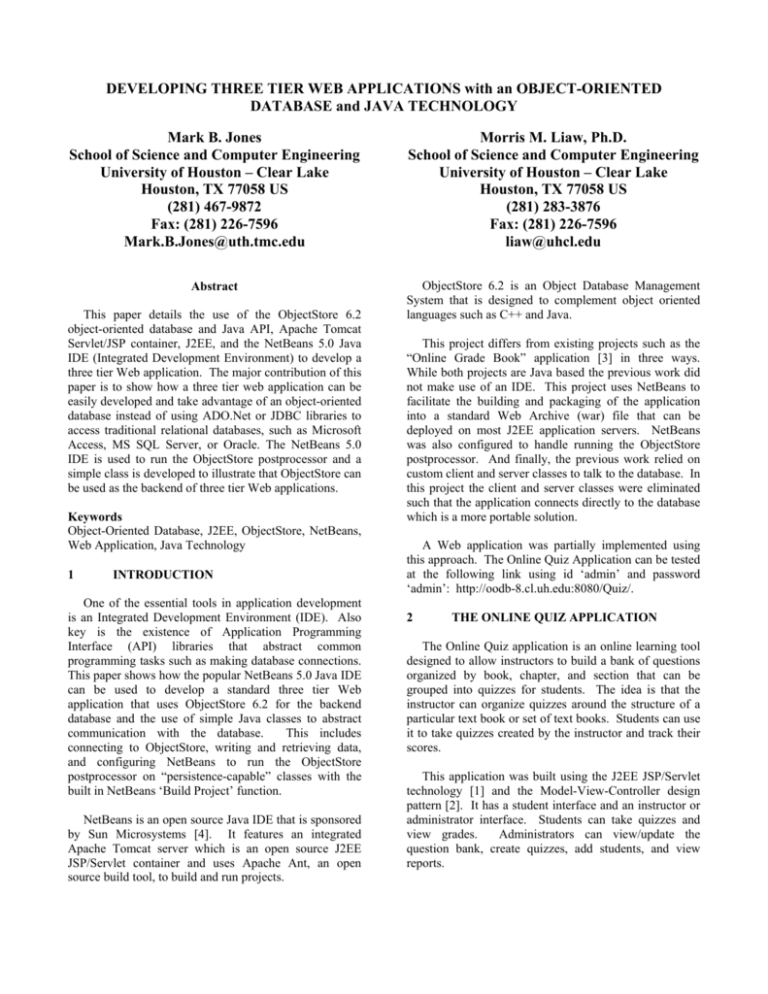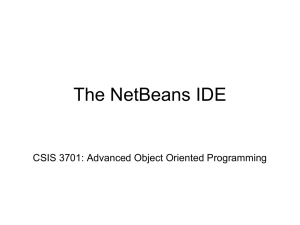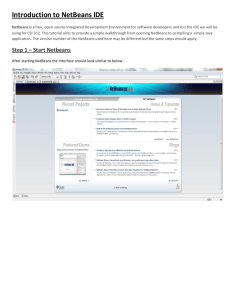Developing Three Tier Web Applications
advertisement

DEVELOPING THREE TIER WEB APPLICATIONS with an OBJECT-ORIENTED
DATABASE and JAVA TECHNOLOGY
Mark B. Jones
School of Science and Computer Engineering
University of Houston – Clear Lake
Houston, TX 77058 US
(281) 467-9872
Fax: (281) 226-7596
Mark.B.Jones@uth.tmc.edu
Morris M. Liaw, Ph.D.
School of Science and Computer Engineering
University of Houston – Clear Lake
Houston, TX 77058 US
(281) 283-3876
Fax: (281) 226-7596
liaw@uhcl.edu
Abstract
ObjectStore 6.2 is an Object Database Management
System that is designed to complement object oriented
languages such as C++ and Java.
This paper details the use of the ObjectStore 6.2
object-oriented database and Java API, Apache Tomcat
Servlet/JSP container, J2EE, and the NetBeans 5.0 Java
IDE (Integrated Development Environment) to develop a
three tier Web application. The major contribution of this
paper is to show how a three tier web application can be
easily developed and take advantage of an object-oriented
database instead of using ADO.Net or JDBC libraries to
access traditional relational databases, such as Microsoft
Access, MS SQL Server, or Oracle. The NetBeans 5.0
IDE is used to run the ObjectStore postprocessor and a
simple class is developed to illustrate that ObjectStore can
be used as the backend of three tier Web applications.
Keywords
Object-Oriented Database, J2EE, ObjectStore, NetBeans,
Web Application, Java Technology
1
INTRODUCTION
One of the essential tools in application development
is an Integrated Development Environment (IDE). Also
key is the existence of Application Programming
Interface (API) libraries that abstract common
programming tasks such as making database connections.
This paper shows how the popular NetBeans 5.0 Java IDE
can be used to develop a standard three tier Web
application that uses ObjectStore 6.2 for the backend
database and the use of simple Java classes to abstract
communication with the database.
This includes
connecting to ObjectStore, writing and retrieving data,
and configuring NetBeans to run the ObjectStore
postprocessor on “persistence-capable” classes with the
built in NetBeans ‘Build Project’ function.
NetBeans is an open source Java IDE that is sponsored
by Sun Microsystems [4]. It features an integrated
Apache Tomcat server which is an open source J2EE
JSP/Servlet container and uses Apache Ant, an open
source build tool, to build and run projects.
This project differs from existing projects such as the
“Online Grade Book” application [3] in three ways.
While both projects are Java based the previous work did
not make use of an IDE. This project uses NetBeans to
facilitate the building and packaging of the application
into a standard Web Archive (war) file that can be
deployed on most J2EE application servers. NetBeans
was also configured to handle running the ObjectStore
postprocessor. And finally, the previous work relied on
custom client and server classes to talk to the database. In
this project the client and server classes were eliminated
such that the application connects directly to the database
which is a more portable solution.
A Web application was partially implemented using
this approach. The Online Quiz Application can be tested
at the following link using id ‘admin’ and password
‘admin’: http://oodb-8.cl.uh.edu:8080/Quiz/.
2
THE ONLINE QUIZ APPLICATION
The Online Quiz application is an online learning tool
designed to allow instructors to build a bank of questions
organized by book, chapter, and section that can be
grouped into quizzes for students. The idea is that the
instructor can organize quizzes around the structure of a
particular text book or set of text books. Students can use
it to take quizzes created by the instructor and track their
scores.
This application was built using the J2EE JSP/Servlet
technology [1] and the Model-View-Controller design
pattern [2]. It has a student interface and an instructor or
administrator interface. Students can take quizzes and
view grades.
Administrators can view/update the
question bank, create quizzes, add students, and view
reports.
The page shown in Figure 1 is the student home page.
From here students can take quizzes or view their grades.
Instructors see the home page shown in figure 2. It lists
some statistics about the contents of the Quiz database
and shows options for viewing/updating the question
bank, creating quizzes, adding students, and viewing
reports.
six Java classes that are stored in the database are run
through the ObjectStore postprocessor, after they are
compiled, in order for them to be made persistencecapable.
The database stores four types of objects in collections
using the ObjectStore class com.odi.util.OSHashMap.
These collections are named objects called ‘roots’. The
four roots are shown in figure 4.
Root Name
“allUsers”
“allQuestions”
Figure 1. Student view home page.
Objects stored
Person: name, ID, password
Question:
Book, chapter, section, question
text
TrueFalseQuestion:
Correct Answer, Student
Response
MultipleChoiceQuestion:
Correct Answers, Student
Responses
“allQuizzes”
Quiz: Name, description,
Questions
“assignedQuizzes” QuizResponse: a Person, a Quiz
Figure 4. Database Root objects
3
Figure 2. Instructor view home page.
Class Name
Persistence
Capable
Description
USING NETBEANS 5.0
One of the challenges to using ObjectStore is the need
to run the postprocessor on classes that will be stored in
the database. This can be overcome and made quite
transparent using the NetBeans IDE.
Controller servlet for
the application
ODB.java
Manages database
connections and
database queries
Person.java
Yes
Stores student and
instructor information
Question.java
Yes
Super class for
question classes
TrueFalseQuesti
Yes
Subclass for true/false
on.java
questions
MultipleChoice
Yes
Subclass for Multiple
Question.java
Choice questions
Quiz.java
Yes
Stores information
about specific quizzes
QuizResponse.j
Yes
Associates specific
ava
students with specific
quizzes
Figure 3. Online Quiz Application middle tier Java
classes
The first task is installing ObjectStore 6.2.
ObjectStore was installed using the default install
configuration on a PC running Microsoft Windows XP
Professional SP 2. NetBeans 5.0 was installed using the
JDK 5.0/NetBeans 5.0 bundle available from
‘java.sun.com’. Next the CLASSPATH environment
variable was added to make the ObjectStore Java libraries
available to the ObjectStore postprocessor when it is
invoked by NetBeans; and the PATH environment
variable was edited to include paths to the Java runtime
and the ObjectStore postprocessor executable.
The Quiz application stores six types of objects
(Shown in figure 3) in four root objects (figure 4). The
NetBeans uses generated Apache Ant scripts to
compile and build projects and it gives the programmer a
Controller.java
Required Environment Variables (assuming the default
ObjectStore install location):
CLASSPATH-c:\ODI\OSJI\tools.jar;c:\ODI\OSJI\osji.jar
PATH-C:\j2sdk1.4.2_12\bin;C:\ODI\OSJI\bin;
The next step is to create a project in NetBeans. Once a
project is created all of the jar libraries from the
…\ODI\OSJI\ directory should be added to the project.
method to insert custom script into these generated
scripts. This is how NetBeans can be configured to run
the ObjectStore postprocessor.
In the ‘nbproject’ folder of the NetBeans project there
is a file named ‘build-impl.xml’. In this file there are
several ‘target’ tags (or elements) like the following.
<target name="-post-compile">
<!-- Empty placeholder for easier customization. -->
<!-- You can override this target in the ../build.xml file. ->
</target>
These ‘target’ tags allow for instructions that are added to
the ‘build.xml’ file to be inserted into the ‘buildimpl.xml’ script when it is invoked by NetBeans. Since
the ObjectStore postprocessor must be run after the class
has been compiled this is where we will need to run the
postprocessor. So the following lines of Ant script were
added to the ‘build.xml’ file.
<target name="-post-compile">
<exec dir="${build.classes.dir}/quiz/"
executable="osjcfp.bat">
<arg line="@cfpargs"/>
</exec>
</target>
ODB odb = new ODB(path);
The ODB class uses code from the ObjectStore API to
open the database connection.
//Open the database or create a new one if necessary.
try {
database = Database.open(DATABASE,
ObjectStore.UPDATE);
} catch (DatabaseNotFoundException e) {
database = Database.create(DATABASE,
ObjectStore.ALL_READ | ObjectStore.ALL_WRITE);
}
The ‘path’ is the path and file name where the database
file exists or will be created. This file can exist anywhere
on the server similar to MS Access MDB files.
All other database communication is abstracted
through the ODB.java class making updating the database
very easy. For example, the following are example calls
to add, retrieve, and delete objects from the database
respectively.
boolean addSuccessful = odb.addPerson(new
Person(firstName,lastName,stuId,stuId));
Person thisUser = odb.getPerson(userName);
boolean deleteSuccessful = odb.deleteQuestion(qText)
This will invoke the ObjectStore postprocessor
(osjcfp.bat) using the command line options specified in
the file ‘cfpargs’. The ‘cfpargs’ file is saved in the
NetBeans project along with the Java source files and
contains the following two lines.
The ODB.java class manages the details of working with
ObjectStore sessions, transactions, and queries using the
ObjectStore API classes.
-inplace -dest .
-pc Person.class Question.class TrueFalseQuestion.class
MultipleChoiceQuestion.class Quiz.class
QuizResponse.class
The development of the Online Quiz application shows
that the NetBeans Java IDE can be used to develop
standard, portable Web applications that take advantage
of an object-oriented database. It further shows that
communication with a database such as ObjectStore can
be accomplished using NetBeans to run the ObjectStore
postprocessor and a simple Java class instead of using
JDBC libraries to access traditional relational databases.
With the NetBeans project configured this way, each
time the NetBeans ‘build’ feature is invoked the
ObjectStore postprocessor is run on the classes specified
in the ‘cfpargs’ file with out any extra effort.
4
CONNECTING TO THE DATABASE
In the Quiz application the ODB.java class is used to
handle connection to and all communication with
ObjectStore. This approach requires that ObjectStore and
Tomcat both be installed on the same server. This is also
the case when using Microsoft Access. Connecting to the
database and issuing queries is quite simple. Using the
ODB.java class connecting to the database only requires
the following simple statement:
5
CONCLUSION
6
REFERENCES
[1] Hall, M., Core Servlets and Java Server Pages. Upper
Saddle River, NJ: Prentice Hall PTR, 2000.
[2] Alur, D., Crupi, J., Malks, D., Core J2EE Patterns:
Best Practices and
Design Strategies, 2nd edition. Upper Saddle River, NJ:
Prentice Hall PTR, 2003.
[3] Moen, Charles R., Liaw, Morris M., “Using an
Object-Oriented Database to Support a Web Application
Built with Java Technologies”
[4] NetBeans.org, “Welcome to the NetBeans
Community”, NetBeans IDE, May 2007
<http://www.netbeans.org/about/index.html>


